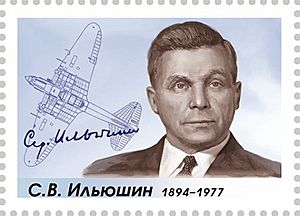Sergey Ilyushin facts for kids
Quick facts for kids
Sergey Vladimirovich Ilyushin
|
|
|---|---|
| Сергей Владимирович Ильюшин | |
 |
|
| Born | 30 March 1894 Dilyalevo, Vologda Governorate, Russian Empire
|
| Died | February 9, 1977 (aged 82) Moscow, Russian SFSR, Soviet Union
|
| Resting place | Novodevichy Cemetery, Moscow |
| Nationality | Soviet Union (Russian) |
| Occupation | Engineer |
| Children | Vladimir Ilyushin |
| Engineering career | |
| Discipline | Aeronautical Engineering |
| Employer(s) | Ilyushin design bureau |
| Significant design | DB-3, Il-2, Il-4, Il-10, Il-12, Il-14, Il-18, Il-22, Il-38, Il-62, Il-76, Il-86 |
| Signature | |
Sergey Vladimirovich Ilyushin (Russian: Серге́й Владимирович Илью́шин; 30 March 1894 – 9 February 1977) was a famous Soviet aircraft designer. He started the Ilyushin aircraft design company. He is best known for designing the Il-2 Shturmovik. This plane first flew in 1939 and became the most produced warplane ever. It is still the second most-produced aircraft in history, with over 36,000 built.
Contents
Biography
Early Life and Aviation Dreams
Sergey Ilyushin was born in a small village called Dilyalevo in Russia. He was the youngest of 11 children in a farming family. He left home when he was very young to find work. He worked many different jobs, like a factory worker and a ditch-digger.
In 1910, he found a job as a groundskeeper at a racetrack in Petrograd (now Saint Petersburg). This racetrack also hosted the first big balloon festival in Russia that year. Ilyushin helped set up equipment and met many early Russian pilots. This experience sparked his interest in aviation.
He continued to work different jobs, including on the Amur Railway and in a shipyard in Tallinn.
Joining the Military and Becoming a Pilot
When World War I started in 1914, Ilyushin joined the Imperial Russian Army. He first served as a foot soldier. Because he could read and write, he later became a clerk.
When the army asked for volunteers for the new Aviation Section, he quickly signed up. He started as a mechanic, helping to keep planes ready. By the summer of 1917, he had learned to fly and became a qualified pilot.
After the war, in 1918, Ilyushin returned to his village. He joined the Bolshevik party. In 1919, he was drafted into the Red Army and worked as an aviation technician. He even helped take apart a captured enemy plane. This plane was later copied to create the Soviet U-1 trainer, which was used to teach many pilots.
Designing Aircraft
In 1921, Ilyushin left the military and began studying at the Institute of Engineers of the Red Air Fleet. He focused on designing gliders and won awards for his designs. In 1925, one of his gliders won first prize in a competition in Germany.
He earned his engineering degree in 1926. He then worked for the Soviet Air Force, helping to decide what new planes should be like. In 1933, he became the head of a design bureau that later became the famous Ilyushin OKB in 1935. This company designed many well-known Soviet aircraft.
His most famous design was the Ilyushin Il-2 ground-attack aircraft. This plane was used a lot during World War II. It is the most produced combat aircraft design in history, with over 36,000 built. He also designed the Ilyushin Il-4 bomber, another important plane during the war.
Later Career and Legacy
After World War II, Ilyushin focused on designing planes for passengers and cargo. He created popular airliners like the Ilyushin Il-18 and Ilyushin Il-62. These planes were used by the Soviet airline Aeroflot and by many other countries.
In 1967, he was given the special rank of General-Colonel of Engineering/Technical Service. He became a member of the Academy of Sciences of the Soviet Union in 1968. He continued to be the chief designer at Ilyushin OKB until he retired in 1970 due to illness.
Sergey Ilyushin passed away in 1977 in Moscow. He was buried in the Novodevichy Cemetery. His work greatly impacted aviation history, especially in the Soviet Union.
Awards and Honors
Sergey Ilyushin received many important awards for his contributions to aviation:
- Hero of Socialist Labour (1941, 1957, 1974)
- Stalin Prize (1941, 1942, 1943, 1946, 1947, 1950, 1952)
- USSR State Prize (1971)
- Lenin Prize (1960)
- Order of Lenin (1937, 1941, 1945, twice in 1954, 1964, 1971, 1974)
- Order of Suvorov 1st and 2nd class (1945, 1944)
- Order of the October Revolution (1969)
- Order of the Red Banner (1944, 1950)
- Order of the Red Banner of Labour (1939)
- Order of the Red Star (1933, 1967)
- International Air & Space Hall of Fame inductee (2006).
See also
 In Spanish: Serguéi Iliushin para niños
In Spanish: Serguéi Iliushin para niños
- His son Vladimir Ilyushin


